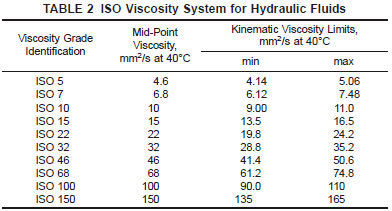

The ideal viscosity range for a fluid-and thus its highest efficiency-is usually between 10 and 100 mm²/sec, depending on the application. The viscosity of a hydraulic fluid is a critical element in the transfer of hydraulic power. At the other extreme, if fluid viscosity is too high, mechanical efficiency is low and that leads to friction during startup, sluggish operation and, in the worst case, cavitation and mechanical failure.

If the oil gets too thin, volumetric efficiency suffers and the system becomes less responsive and can lead to overheating, high wear and shorter component life. As oil temperature rises, viscosity drops and it flows more easily-to a point. They are generally selected based on the oil’s viscosity for use in a certain type of equipment operating over a specific temperature range.ĭetermining the right fluid viscosity is a balancing act.
LOW VISCOSITY HYDRAULIC OIL ISO
The fluids are most-often labeled in terms of ISO number or grade, where common grades for hydraulic circuits include ISO VG 32, 46 and 68. Manufacturers of hydraulic fluid provide various products with different viscosities. Viscosity is measured in centistokes or mm2/sec, where 1 cSt = 1 mm2/sec. It’s usually shown in spec sheets at temperatures of 40° and 100° C. The most common unit of measure for viscosity is kinematic viscosity, which gages how easily oil flows under the force of gravity. Also, as hydraulic fluid ages or experiences shear stress, oil molecules can break down and that lowers the viscosity. When a hydraulic oil is too thick (high viscosity), the fluid will be more difficult to pump through the system and may reduce operating efficiency. The hydrocarbon molecules in mineral oil vary in size, while synthetic oils have a more-consistently sized make-up. When a hydraulic oil is too thin (low viscosity), it does not seal sufficiently. Viscosity is a critical property of hydraulic oil, as it affects the performance and efficiency of complete systems as well as the wear rates of individual components like pumps and valves.Ī hydraulic fluid’s viscosity is defined primarily by the size and structure of its molecule chains-the larger the molecules, the thicker the fluid. (Fluids that have no resistance to shear stress are known as ideal fluids or “superfluids.” Zero viscosity is observed only at extremely low temperatures.)

For example, water is less viscous than tar. Or, in more simple terms, how thick or thin a fluid is. Viscosity, according to Webster’s Dictionary, is the property of fluids and semi-fluids that defines its internal resistance to flow and shear.


 0 kommentar(er)
0 kommentar(er)
